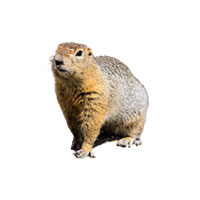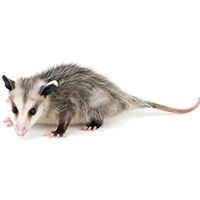Fast Facts![]()
| Color | Woodchucks are brown overall but may look “frosted” because each hair is tipped with black and white bands. |
| Size | 
Adults measure 16-27″ including, a 4-7″ tail and weigh between 5-10 pounds. Their tail is short relative to their body size. Woodchucks have four toes on the front paws and five toes on the back paws. The prints are about 1.5″ long. When walking, the tracks are spaced about 4″ apart. They are 12″ apart when running. |
| Appearance | Woodchucks are round, short-legged animals that belong to the squirrel family. Being an expert burrower, they have powerful forefeet with long, curved claws. They also have very sharp chisel-like front teeth, small ears, and large black eyes. |
Woodchuck Diet
Woodchucks are mostly vegetarian and feed on a variety of fruits and green plants, including clovers, grasses, ferns, and leaves of bushes and trees. If they have access to a garden, they will eat peas, beans, corn, carrots, lettuce, apples, and other garden crops. Woodchucks may also eat flowers, insects, and the bark of young trees. They also occasionally eat snails, insects, eggs, and young birds. They prefer to feed in the early morning and evening. An adult woodchuck can consume one to one and a half pounds of vegetation per day.
Woodchuck Habitat
Woodchucks are found throughout Wisconsin, most commonly in agricultural and other areas with abundant food sources. They prefer dry soils with well-vegetated, open woodlands, farmlands and field edges such as crop fields, meadows or pastures that are close to a wooded edge. While they prefer rural, open lands, they have also adapted to urban settings and can be found living in gardens, parks, and golf courses. Woodchucks live primarily underground in burrows dug on land with a slight slope. The burrows can be up to five feet deep and 60 feet or more long. Since woodchucks spend much of their time underground, they avoid low-lying areas that flood regularly.
Woodchucks use two types of burrows, one for winter and one for summer. Winter burrows are often dug in wooded areas and have only one opening. The end of the burrow is lined with grass to create a nest and the entrance is blocked off with soil during hibernation. In the summer, they move to grassy areas where they dig a burrow with two or more entrances. The main entrance is typically ten to twelve inches wide and will have a mound of soil next to it. Other entrances are dug from below the soil surface and provide a quick, easy escape route from predators. Burrow systems are quite complex, each containing a main nest chamber, a toilet chamber located away from the main nest, and additional chambers found throughout the burrow. Woodchucks are typically solitary animals, except for when they are mating. At that time, a male and female will share a burrow.
Woodchuck Life Cycle
Woodchuck mating season is from March to April. The gestation period is 32 days long with one litter of two to six young born per year. The young leave the den around mid-July when they can survive on their own. Young woodchucks will start looking for their own living space when they are approximately two months old. They do not breed until their second year and their average life span is only three years.
Woodchuck Damage
There are two ways in which woodchucks can cause problems to the property as a result of their feeding and burrowing habits.
Feeding
Their taste for flowers and vegetables and constant gnawing can cause damage in orchards and nurseries, on farms, and in-home gardens. Damage to crops can be extensive. They gnaw and claw fruit trees and ornamental shrubs. Woodchucks have been known to gnaw on underground power cables, which can cause electrical outages.
Burrows
Their burrowing can pose problems in both rural and urban locations. Cutter blades on farm equipment can be damaged from the mounds of dirt at burrow entrances, and livestock can be seriously injured if they stumble into woodchuck holes. Horses and their riders can be injured this way as well. In urban settings, their tunnels can cause driveways and parking lots to cave in and rock walls to collapse. Their burrowing along building foundations can cause damage that undermines the whole structure, resulting in costly repairs.
Woodchuck Prevention & Control
Woodchuck Prevention
Like many pests, the best way to get rid of woodchucks is to prevent them from invading your property in the first place. The two best methods to prevent woodchucks are habitat modification and exclusion.
Habitat Modification
Given their habitat requirements, it is difficult to modify the property to discourage woodchucks. Properties with some slope to the land will be more likely to attract woodchucks than those that are relatively flat.
Exclusion
If there is a small area of the property that you want to protect from woodchucks, such as a garden, a group of fruit trees, or ornamental shrubs, fencing can help reduce the damage. Since woodchucks are surprisingly good climbers, fencing them out requires a two-angle approach. The fence should be made from metal mesh/wire material, extend 10-12″ below the soil surface and be at least four feet tall above ground. It should have an outward pointing “lip” both at the top and bottom. The top of the fence should make a 45-degree angle to prevent the woodchuck from climbing over the fence. Another option is to leave the top 12” unattached to fence posts so that when a woodchuck tries to go over the top, its weight will flip it back.
Since they burrow, a wire deterrent below the ground must be used to keep them from digging under the fence. Bury the wire 12-14″ underground, bending the lower edge (bottom 2-4″) of the wire at a 90-degree angle pointing out from the fence line. Use hardware wire to exclude woodchucks from digging under porches and decks.
Other Tips Include:
- Eliminate woodpiles and other places where woodchucks nest.
- Keep undergrowth and grass cover low to deter woodchucks.
- Close down vacant tunnel systems by burying welded wire centered over the entrance. Woodchucks will use vacant burrows.
Woodchuck Control
Removal of a woodchuck is only necessary if the animal is causing substantial property damage or is a public health or safety concern. If you remove the animal causing damage without modifying the habitat, be prepared to have another woodchuck take up residence. The best method to control woodchucks is exclusion – keeping them out is easier than removing them.
Much of wildlife control is knowing and understanding the habitat and behavior of the animal. For woodchucks, Batzner uses live trapping with vegetables, cantaloupe, sweet corn, lettuce, canned peaches, or fruit cocktail. The trap needs to be set early morning before the woodchuck emerges for the day. Secondary openings will need to be blocked off to funnel the woodchuck into the trap from the main burrow.
If you’re having problems with woodchucks around your home or business, contact a pest control professional for expert removal services.
Need help with Woodchucks?
We'll call you! Leave your information below.





